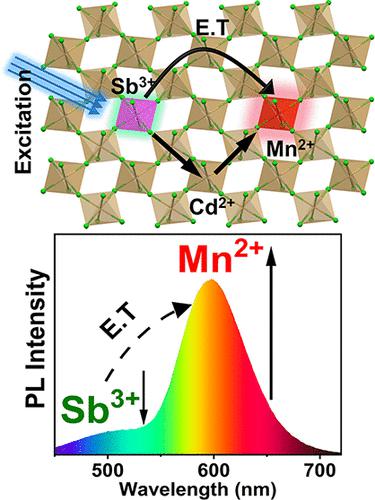当前位置:
X-MOL 学术
›
J. Phys. Chem. Lett.
›
论文详情
Our official English website, www.x-mol.net, welcomes your feedback! (Note: you will need to create a separate account there.)
Strong Dopant–Dopant Electronic Coupling in Emissive Codoped Two Dimensional Metal Halide Hybrid
The Journal of Physical Chemistry Letters ( IF 5.7 ) Pub Date : 2023-05-22 , DOI: 10.1021/acs.jpclett.3c00902 Ashwath Kudlu 1 , Deep Kumar Das 1 , Rangarajan Bakthavatsalam 1 , Jisvin Sam 1 , Soumyadip Ray 1, 2 , Padmabati Mondal 1, 2 , Sudipta Dutta 1 , Venkatesha R Hathwar 3 , Raghavaiah Pallepogu 4 , Janardan Kundu 1
The Journal of Physical Chemistry Letters ( IF 5.7 ) Pub Date : 2023-05-22 , DOI: 10.1021/acs.jpclett.3c00902 Ashwath Kudlu 1 , Deep Kumar Das 1 , Rangarajan Bakthavatsalam 1 , Jisvin Sam 1 , Soumyadip Ray 1, 2 , Padmabati Mondal 1, 2 , Sudipta Dutta 1 , Venkatesha R Hathwar 3 , Raghavaiah Pallepogu 4 , Janardan Kundu 1
Affiliation

|
Multimetallic halide hybrids are attractive for the fundamental understanding of interacting excitons. However, realizing halide hybrids that incorporate multiple heterometal centers has been synthetically challenging. This further limits access to gaining physical insight into the electronic coupling mechanism between the constituent metal halide units. Reported herein is an emissive heterometallic halide hybrid, synthesized by codoping (with Mn2+, Sb3+) a 2D host (C6H22N4CdCl6) hybrid, that shows strong dopant–dopant interaction. Here, C6H22N4Sb0.003Mn0.128Cd0.868Cl6 codoped hybrid shows weak green emission (Sb3+ dopant based) and strong orange emission (Mn2+ dopant based). The observed dominance of the Mn2+ dopant emission, arising due to efficient energy transfer between the distant dopants (Sb3+ → Mn2+), highlights strong dopant–dopant electronic coupling. DFT calculations, supporting the observed dopant–dopant interaction, suggest that the electronic coupling between the dopant units (Mn–Cl; Sb–Cl) is mediated by the 2D networked host structure. This work reports physical insight into the coupling mechanism of interacting excitons in multimetallic halide hybrids synthesized through a codoping strategy.
中文翻译:

发射共掺杂二维金属卤化物杂化物中的强掺杂剂-掺杂剂电子耦合
多金属卤化物杂化物对于相互作用激子的基本理解很有吸引力。然而,实现包含多个异金属中心的卤化物杂化物在综合上具有挑战性。这进一步限制了获得对构成金属卤化物单元之间的电子耦合机制的物理洞察力。本文报道的是一种发光异金属卤化物杂化物,通过共掺杂(与 Mn 2+、 Sb 3+)合成二维主体(C 6 H 22 N 4 CdCl 6)杂化物,显示出强烈的掺杂剂-掺杂剂相互作用。这里,C 6 H 22 N 4 Sb 0.003 Mn 0.128Cd 0.868 Cl 6共掺杂杂化物显示弱绿色发射(基于Sb 3+掺杂剂)和强橙色发射(基于Mn 2+掺杂剂)。由于远距离掺杂剂 (Sb 3+ → Mn 2+ )之间的有效能量转移,观察到的 Mn 2+掺杂剂发射占主导地位,突出了强掺杂剂-掺杂剂电子耦合。DFT 计算支持观察到的掺杂剂-掺杂剂相互作用,表明掺杂剂单元(Mn-Cl;Sb-Cl)之间的电子耦合是由二维网络主体结构介导的。这项工作报告了对通过共掺杂策略合成的多金属卤化物杂化物中相互作用激子的耦合机制的物理洞察。
更新日期:2023-05-22
中文翻译:

发射共掺杂二维金属卤化物杂化物中的强掺杂剂-掺杂剂电子耦合
多金属卤化物杂化物对于相互作用激子的基本理解很有吸引力。然而,实现包含多个异金属中心的卤化物杂化物在综合上具有挑战性。这进一步限制了获得对构成金属卤化物单元之间的电子耦合机制的物理洞察力。本文报道的是一种发光异金属卤化物杂化物,通过共掺杂(与 Mn 2+、 Sb 3+)合成二维主体(C 6 H 22 N 4 CdCl 6)杂化物,显示出强烈的掺杂剂-掺杂剂相互作用。这里,C 6 H 22 N 4 Sb 0.003 Mn 0.128Cd 0.868 Cl 6共掺杂杂化物显示弱绿色发射(基于Sb 3+掺杂剂)和强橙色发射(基于Mn 2+掺杂剂)。由于远距离掺杂剂 (Sb 3+ → Mn 2+ )之间的有效能量转移,观察到的 Mn 2+掺杂剂发射占主导地位,突出了强掺杂剂-掺杂剂电子耦合。DFT 计算支持观察到的掺杂剂-掺杂剂相互作用,表明掺杂剂单元(Mn-Cl;Sb-Cl)之间的电子耦合是由二维网络主体结构介导的。这项工作报告了对通过共掺杂策略合成的多金属卤化物杂化物中相互作用激子的耦合机制的物理洞察。

























 京公网安备 11010802027423号
京公网安备 11010802027423号